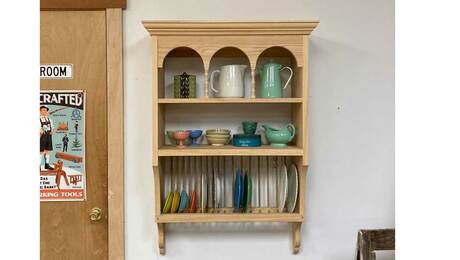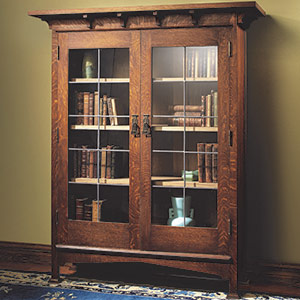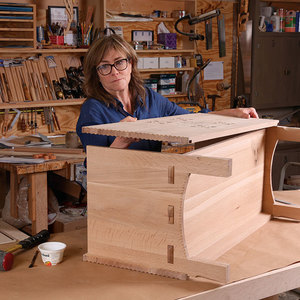Marketing for Woodworkers: Print Ads
Darrell Peart credits his ads in print periodicals with making his name one of the most widely known among those who specialize in Arts and Crafts work
This is part of a series about different marketing tools for woodworkers. The others are linked below.
There’s a widely held view that print is a dying medium. Print is not dying; it’s changing in response to pressure from the web. One result: Many print publications are upping their production values in an effort to keep subscribers and advertisers involved. Advertising in magazines can be a very effective means to marketing your work. Granted, a two-dimensional image on a page won’t allow potential clients to run their hands across a tabletop or test the comfort of a chair, but it can still pack a powerful visual punch. A well-designed ad is eye-catching and instantly links your name to your work.
One furniture maker who understands the potential value of print advertising is Darrell Peart. Peart has been a professional woodworker since the early 1970s and has made his living as a furniture maker for most of that time. He credits his ads in print periodicals with making his name one of the most widely known among those who specialize in Arts and Crafts work. Here are some key pieces of advice from Peart based on his experience.
1) Use high-quality images
It’s worth paying a professional photographer. Over time, Peart developed his skills by learning from professionals, then transitioned to doing his own photography. “Today,” he adds, “if I have a special piece, I’ll still hire a professional.”
2) Repetition is key
“One ad won’t do it,” Peart says. You need to advertise over a few years. Then people will know who you are. Don’t expect a big return (or any discernible return) on one particular ad. The value of advertising comes from repeated exposure.
3) Be patient
Advertising is a long-term investment in growing your name recognition.
4) Choose wisely
Pick the publication(s) in which you’re going to advertise based on the subject matter and production values. Readers will associate you and your work with the character of the publication(s) in which they see your ad. If you specialize in Victorian-style armoires, you’re going to be wasting your money by placing ads in periodicals that specialize in mid-century ranches. Peart got many orders from his full-page ads in American Bungalow; he also advertised in Style:1900 (no longer being published), Old-House Interiors (now subsumed into Old-House Journal), and Arts and Crafts Homes and the Revival (now a stand-alone website with an annual book-quality publication, the first coming in October). Each specializes in articles about homes and furnishings that complement Peart’s work.
5) Link your ad to your website
Peart launched his first website in 1995, getting into the game early and scoring the covetable “furnituremaker.com,” which gave him high rankings in search results. While he says he “lucked out,” his experience suggests that in some cases it pays to be an early adopter of new marketing modes.
6) Nothing beats word of mouth
There’s no better advertisement for your work than having it in people’s houses. Friends and relatives visit, admire the work, and ask who made it. Word of mouth alone may not keep you in business, but it’s invaluable.
Finally, on a general note, Peart stresses two reasons for keeping a day job. Throughout his career he has been a professional woodworker—but for much of that time he was working in other people’s shops. Over the years he built cabinets, high-end millwork, and furniture, learning an enormous variety of skills and different approaches from others. In addition, those day jobs allowed him to pick and choose the kind of work he wanted to do under his own name. “Having that day job allowed me to only take on the side jobs I wanted in my business. I got known for that particular style. If something else came in, I would refer them to someone else.”
Finally, always ask prospective clients how they became aware of your work. It’s the surest way to gauge how well your marketing efforts are performing.
-Nancy Hiller
Nancy Hiller is a professional cabinetmaker who has operated NR Hiller Design, Inc. since 1995. Her most recent books are English Arts & Crafts Furniture and Making Things Work, both available at Nancy’s website.
More on FineWoodworking.com:
- Marketing for Woodworkers: Shows, festivals, and exhibitions by Nancy R. Hiller with Michael Fortune
- 5 Tips for Dealing with Difficult Clients – As long as you have to sell your work to make a living, you’re working for someone else: your customer
- Nancy Hiller’s Reality Check(list) – If you’re thinking of turning your passion into a profession you should take a deep look at what is involved in running a legitimate business.
- A Woodworker’s Guide to Photography by Michael Pekovich – #213–July/Aug 2010 Issue





















Comments
The article makes some good points, but I'm skeptical. All the print venues mentioned are either extinct or have been bought out or evolved. Mr. Peart got on the internet at the right time and he's been around "forever" in today's 24-hr news cycle.
If you use any advertising you should do your research and ask your customers where they learned of your services. It's called research, and should have been mentioned in this article.
Only a segment of your audience is going to see ads in printed edition of magazines. Losing other opportunities seems rather bad advice
In reply to jodiegraham: There is no suggestion here, implicit or explicit, that advertising in print magazines should be the only way to market one's work. This post is one in a series about different methods that successful woodworkers market their work. The idea behind the series is that readers may learn something valuable from Fortune, Peart, and others about *how* to use a range of different methods for marketing in order to maximize the odds of getting good results.
Please also bear in mind that your note about "Only a segment of your audience" being likely to see print ads applies to marketing efforts across the board. Many people seem to assume that material posted on various internet sites has universal reach. It doesn't. While the reach of some modalities, such as Instagram, is in principle unlimited, it does not work that way in reality. To see the posts of a given account, you must either follow it or stumble across it in a search. Even those who follow a given account don't see every post via their feed; to be sure of seeing everything, you have to take the time to look up the profile of the account. On top of this, many people simply don't use social media. I know lots of young people, as well as middle aged and older people, who eschew social media of any kind.
There's no substitute for a broad range of marketing modalities. I included print in this series specifically because so many people routinely write it off as ineffective today. Some of us continue to find print advertising a very worthwhile means to marketing our work.
In reply to DuaneD: Yes, print media -- like all other media -- are continually evolving. That’s the only way to survive. I noted this in reference to each publication I mentioned, pointing out the cases in which particular publications have ceased to exist or been subsumed by others. The fact that these periodicals have changed and continue to do so in no way argues against their potential value as vehicles for marketing.
Your point about asking customers how they learned of your business is excellent. It's something I do whenever a prospective client contacts me; I've done so for decades. I will have this added to the post for future readers. Thank you for mentioning it.
Log in or create an account to post a comment.
Sign up Log in